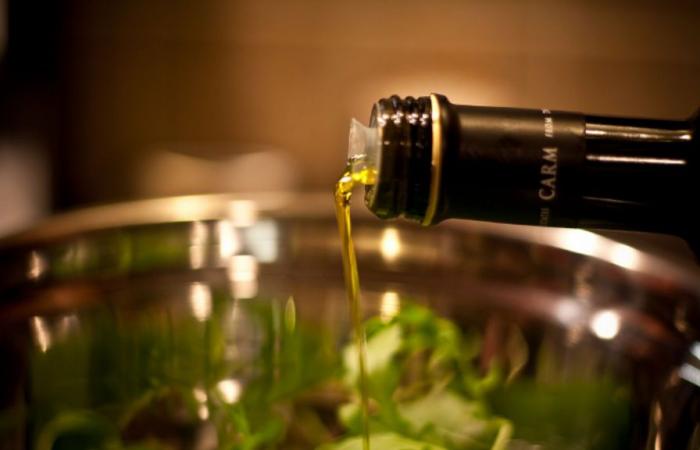Olive Oil Times expects local production of around 1.5 Mt for the 2024/2025 financial year, a record level, while the harvest, which began in October, continues until February. During the 2022/2023 campaign, Spain hit rock bottom with a production of 0.67 Mt.
“Most of the olive trees in Spain are century-old trees, explains Julio Urruela, administrator at the international center for advanced Mediterranean agronomic studies (Ciheam). These trees are subject to the cyclical phenomenon known as “vecería”, or the succession of good years of production to bad ones – and vice versa.” While the crops are very resilient, climate change and the intensity of drought have put a strain on the trees, even though these olive groves are located in regions where, historically, access to water is more restricted. The country is investing to increase the resilience of production.
Room for falling prices – Source: COI, Monthly Report, October 2024
Intensive and irrigated production is developing
New systems are developing. “There are investments in intensive and mechanized plantations, with access to irrigation”continues Ramzi Belkhodja, coordinator for production and plant health at Ciheam. These intensive olive groves, although they are still a minority in Spain, provide a production reserve in the event of a rain deficit in the historic basins. Precision irrigation projects are emerging. In any case, Ciheam echoes production costs in these intensive systems contained at 1000 euros per tonne, compared to 4500 in traditional olive groves.
These developments are not only happening in Spain. Turkey, although it is a historic producer due to strong domestic demand, took an important place on the markets during the last campaign. The homeland of the Janissaries, whose production was around 0.2 Mt in recent years, has almost doubled the latter, stealing the second place in the ranking of producers from Greece and Italy, the contenders usual for the second step of the podium.
Turkey wants its piece of the pie
Local authorities even announce that they are counting on a further increase in production for the coming campaign to 0.46 Mt, as reported by the local edition of Bloomberg. Ciheam experts are, to say the least, skeptical about this increase in production, noting that the COI is counting on a return to normal with a production of 0.21 Mt. In its latest report on olive oil published at the end October, FranceAgriMer points out, however, that the country has adopted “an olive orchard expansion plan” and has invested in “innovative equipment”. The country is mechanizing its orchard, increasing tree density and developing irrigation.
The Turkish state is pursuing a precise plan. “Historically, Turkey exports around half of its oil in bulk, mainly to manufacturers in Spain in particular, explains our local market expert. In recent months, the State has increased restrictions on these bulk exports to force local manufacturers to develop brands.”
The plunder of Syrian oil fuels the Turkish machine
FranceAgriMer also notes that among the main world exporters, Turkey is the country with the lowest export value, at 4.19 euros per kilo, compared to 5.29 euros for Spain and even 6.38 euros for ‘Italy. The Tunisian model, and particularly the success story Terra Delyssa, which has made a place for itself on the shelves with positioning premiumcould be emulated.
A good follower of agricultural issues established in the region provides a complementary explanation: “Turkish troops are present in northern Syria, a major olive oil production area. Like the Russians with Ukrainian cereals, the Turks are recovering local production.” The production figures of the country led by Erdogan will therefore be worth monitoring in the coming months. They could contribute to amplifying the price falls expected by the markets, after historic years due to the shortage of supply.
Around the world, appetite for production
Especially since, in addition to Turkey, a host of new entrants hope to grab a share of the pie while the record prices of recent years and the vulnerability of Mediterranean production have acted as a breath of fresh air. Plantations are multiplying in the United States, China, Pakistan… “More than 60 million trees have been planted in Saudi Arabia”welcome Ramzi Belkhodja.
And France in all this? With a production of 3,700 tonnes during the 2022/2023 campaign, the country clings to its role as an anecdotal producer on the world stage, despite consumption of around 130,000 tonnes. The uprooting of vines in Bordeaux could leave some room for production.
The American dream, last stand for a demand at half mast?
Newcomers are particularly eyeing the American market. Because it is an important fact: olive oil, praised for its health benefits, is on the rise, even if inflation has tempered the good growth of the last ten years (around 0.1 Mt additional ). “We consider the United States as a key pillar of growth for the years to come,” says Deoleo, one of the world leaders in olive oil, best known in France for its Carrapelli brand. (…) With only 45% of American households using olive oil, there is substantial growth potential.”
Attempts to advance olive oil in Uncle Sam’s country, however, are not always successful: proof with Starbucks and its coffees infused with olive oil which have lived for nineteen months: l The initiative was stopped on the sly according to information from Olive Oil Times published at the beginning of November.
A lasting slowdown in Europe?
But while new markets are opening up, traditional markets have suffered greatly with inflation. Europe, where we traditionally consume around 1.5 Mt of olive oil each year, consumption has fallen to 1.2 Mt – which is also linked to the supply deficit. Inflation has confirmed the high price elasticity for the most expensive oil. Spain, where each inhabitant traditionally guzzles more than 11 liters of olive oil in the year – it is less than 2 in France – has fallen to the lowest step on the podium of consuming countries, dethroned by Italy and the United States. The price reductions, linked to the exceptional production that is expected, are eagerly awaited.
“According to COI economic experts, olive oil consumption will not recover as quickly as production. The consumption of olive oil remains in fact faced with competition from other vegetable oils,” indicates FranceAgriMer to L’Usine Nouvelle. A new signal which could accentuate the bearish movement.






